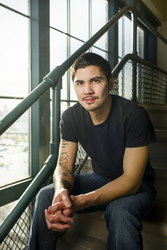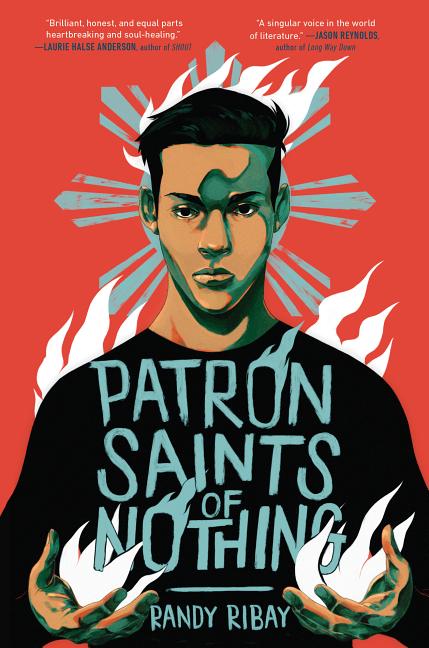From Teaching to Writing

TeachingBooks asks each author or illustrator to reflect on their journey from teaching to writing. Enjoy the following from Randy Ribay.
How did teaching influence the writing of Patron Saints of Nothing?
Ask a group of teenagers what TV show they’re bingeing or what video games they’re playing, and you’ll have a hard time ending that discussion. Ask them what they’re reading for fun, and – outside of a handful of kids – you’ll have a hard time even turning that into a conversation. I love stories in all mediums, but as an English teacher and author, it saddens me that discussions about books don’t even come close to generating the same excitement with my students as TV or video games do.
Why is that?
If you’ve been working with teens for a while, you know they’re more stressed out than ever before. Our society is continually raising the bar for what it means to be a successful young person, so most of them have schedules packed with homework, extracurricular activities, family obligations, church/synagogue/temple involvement, volunteer gigs, college apps, part-time jobs, and friends. We also constantly tell them that our world is broken and it’s up to them to fix it, readily offering examples of teen activists to coerce our teens to do more, be more. Even the trend toward self-care paradoxically creates more stress as students stress over being overstressed.
Through language, a book puts us directly into the consciousness of another human being in a way no other medium can.
So, it’s no wonder that when teens have free time, most turn to social media, YouTube, Netflix, video games, etc. before they pick up a book for fun. I don’t blame them because these forms of media are relevant and engaging in a way that most teens don’t perceive books to be, and they don’t require the same absolute attention demanded by a book.
Still, I believe in the unique value of reading – definitely not just as a means to such an end as higher standardized testing scores. Through language, a book puts us directly into the consciousness of another human being in a way no other medium can. But as valuable and transformative as this can be, it’s up to those of us who understand it most to convince the next generation that books are worth their free time and their full attention. Of course, we don’t do this by simply telling them. We do this by connecting them with books that allow them to experience this power for themselves.
The teachers who have had the most success turning kids onto reading are those who already know this and have been working hard to put such books into their students’ hands. They devour the latest releases or best sellers or award winners so that they can recommend the exact right book. They read outside of their own experiences. They talk excitedly about their own reading habits with their classes. They challenge the literary canon. They run lit circles or engage kids in independent reading. They connect with other educators who get it. I believe that teachers like this are ultimately on a perpetual hunt for books that will prove as relevant and as engaging to their students as any TV show or video game might be because they know those books exist.
Understanding this as a teacher makes me want to write such books as an author. So, how do I do it? (Or, at least, how do I try to do it?)
Let’s start with relevancy. To me, this means the reader can connect with a book in a personal way. It seems to be speaking directly to them in the particular moment at which they’re reading it, and therefore it truly matters. As an author of books for young people, this begins with understanding the universal experiences of growing up. More specifically, as someone who writes young adult books, this means understanding that young adulthood – no matter where, no matter when – is ultimately about that time in your life when you’re trying to figure out who you are outside of your family. In Patron Saints of Nothing, for example, Jay’s search for truth about his cousin’s death causes him to confront all of these ideas he’s subconsciously inherited from his family – ideas about his racial and national identity, about religion and morality, about masculinity, about the Philippines, and about his family itself. I try to keep this at the core of the story, so whatever’s happening in the plot is ultimately pushing Jay through a process of identity formation that I hope any teen can relate to.
Relevancy also operates at levels of increasing particularity. Someone who’s biracial might find Patron Saints of Nothing more relevant than someone who isn’t. Someone who’s White and Filipinx might find it more relevant than someone who is biracial in another way. Someone who’s White and Filipinx and lives in a mostly White community might relate more than someone who’s White and Filipinx and lives somewhere with a significant Filipinx American population. I could go on asymptotically, but you probably get the point.
So we need stories by and about traditionally marginalized communities if we are to live in a world where all readers can find authentic books (plural!) that are particularly relevant to them.
Of course, it’s impossible to write a story that’s particularly relevant to every single reader since every single reader is different. And that’s okay. Actually, it’s necessary not to try to do so. The human experience is vast and varied. Unfortunately, publishing trends have not and still do not accurately reflect the demographics of our country’s population, making many of us think our stories matter less. Thankfully, over the last few decades, scholars from traditionally marginalized backgrounds like Rudine Sims Bishop have pushed us to understand the necessity of both reading stories that mirror familiar experiences and stories that offer a window into unfamiliar experiences. So we need stories by and about traditionally marginalized communities if we are to live in a world where all readers can find authentic books (plural!) that are particularly relevant to them. Understanding this as a teacher gave me permission to lean into writing a particular story about and for Filipino American teens. And when I faced rejections from agents and editors, I kept going because I believed in the necessity of the story.
Slipping back to my teacher-side for a moment, this is why it’s essential that we go beyond the literary canon in our classrooms. There are always those who object, saying, “They’re classics for a reason!” appealing to some sense of objective quality and universality. But such a stance completely ignores the fact that a big part of the reason those texts are considered “classic” is because those who historically have had the power to determine curricula turned their shared particular experiences (generally: White, male, cis-heteronormative, and upper-middle-class) into some false universal baseline perpetuated by every time we reference those texts as objective classics. To offer truly relevant texts, there must also be space in our curriculum to allow educators to connect kids with books that are culturally or personally relevant to them.
Okay. Back to my author-side.
If, for me, to write a relevant book is more of a philosophical approach that requires a deep appreciation of both universal and particular relevancy, then trying to write a book that’s engaging – essentially, one that’s binge-worthy – is much more technical and comes down to the basics elements of storytelling: setting, characters, and plot. I believe what an author chooses to emphasize is a matter of genre and subjective personal tastes, so I basically try to follow the advice of writing the story that I want to read when it comes to contemporary fiction.
In terms of developing the setting for Patron Saints of Nothing, this meant trying my best to accurately depict the Philippines (specifically Metro Manila and Bicol) three years into the Drug War as concisely as possible. I strove to include enough context and setting descriptions so the reader feels immersed, but not so much that they feel bogged down. Regarding plot, this meant setting up a clear question (What actually happened to Jun?) and creating enough tension that sustains the reader’s desire to pursue the answer for over three hundred pages. Finally, with characterization, it meant doing my best to populate the story with people that feel like authentic human beings. People who are complex, nuanced, and flawed. People you come to understand better the more time you spend with them. People, who, like all of us, are works-in-progress.
Both as an educator and a writer, I’m not here for the paycheck. I’m doing what I’m doing to turn kids into readers. Like many of you, I understand the power of literature to transform through empathy and create a better world, and I want my students and readers to understand all of this too. I hope that you’ll find Patron Saints of Nothing is the kind of story that will make this easier for you, and I hope that if you give your kids the space to discuss it in your class, they’ll have as much to say – if not more – than whatever’s trending on Netflix.
Books and Resources

TeachingBooks personalizes connections to books and authors. Enjoy the following on Randy Ribay and the books he’s created.
Listen to Randy Ribay talking with TeachingBooks about the backstory for writing Patron Saints of Nothing. You can click the player below or experience the recording on TeachingBooks, where you can read along as you listen, and also translate the text to another language.
- Listen to Randy Ribay talk about his name.
- Explore TeachingBooks’ collection of activities and resources for Patron Saints of Nothing
- Find a Book Guide for Patron Saints of Nothing
- Discover Randy Ribay’s page and books on TeachingBooks.
- Randy Ribay on his website, Instagram, Facebook, and Twitter.
Explore all of the For Teachers, By Teachers blog posts.
Special thanks to Randy Ribay and Penguin Books for Young Readers for their support of this post. All text and images are courtesy of Randy Ribay and Penguin Books for Young Readers, and may not be used without expressed written consent.



Leave a Reply